Description
| White Worm Information White Worms Enchytraeus albidus |
|
| Origin | Moist soils |
| Size | Little over an inch |
| Temperature | 55 o to 60 o best. Up to 70o |
| Water | Keep soil damp but not moist |
| Threats | Ants, maggots, and mice |
| Foods | Brewer’s Yeast, Cooked White Rice, White bread buttered with plain yogurt and even fish flakes. |
| Supplements | Sodium bicarbonate |
| Lighting | Keep in dark |
| Medium | Coconut coir or peat moss. Regular garden soil can be used as well but we use coconut coir. |
| Containers | Covered plastic shoe boxes |
| Maintenance | Weekly feedings |
| Harvesting | Remove clumps and rinse |
| Sorting | Swirl water to sort out sizes |
Origins: White worms grow wild in soils that stay damp. You can find them growing wild in compost bins. Unfortunately, you have to sort them out from the other stuff.
Appeal: Fish love the taste of white worms – even the pickiest eaters. Caution: Bettas gorge themselves and can rupture their bellies. 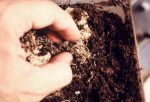

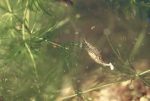
Size: Adult white worms grow to slightly over an inch. They breed before that size. Their size makes them ideal for two to five-inch fish. You can sort out smaller worms by swirling them in a gallon jar of water. The large ones fall to the bottom first. Just pour off the still swirling smaller worms and feed them to smaller fishes or return them to your culture. Watch smaller fishes fight over one of these. Neither one wants to give up, and the worm is stronger than both.
Sexes: Like earthworms and other annelids, white worms are hermaphroditic. Each worm contains male and female breeding equipment. They swap sperm with each other like nightcrawlers.
Eggs: White worms strew their eggs throughout their media. Save all “used” dirt because it contains numerous eggs. The clear eggs are hard to see. You’ll also get little springtails that look like eggs — jumpy eggs.
Negative Phototropic: White worms avoid the light. They start burrowing into the dirt as soon as the light comes on. This makes them difficult to harvest.
Noise: White worms have no ears but easily detect vibrations. If their box or shelves get bumped, they will retreat further into the soil. They cannot be kept where a lot of activity takes place.
Foods: White worms will accept dozens of foods. The best production results from plain Brewer’s yeast sprinkled on the bedding lightly. We also feed small amounts of cooked white rice. White bread buttered with yogurt and then sprinkled with Brewer’s yeast works well too. Large amounts of food reduces production or causes problems. For instance, wheat bread grows mold in two days. White breads contain mold preventing chemicals. They rarely mold. Grains can cause mites and fruit flies and that sort of thing.
Feeding Schedule: Feed small amounts at first (without crusts). Increase the amounts until the culture eats a slice of bread per week. The worms are now ready to harvest on a weekly basis or divide in half to make new cultures.
Supplements: Mix some sodium bicarbonate into the soil to reduce the acidity that comes from the peat moss and digested food.
Moisture: Add sufficient water to thoroughly soak the peat moss. You may have to boil it. Mix it with soil and squeeze a handful. If it turns into mud, that’s too wet. If it falls apart, that’s too dry. If it forms a loose ball, that’s just right. It may take a week to achieve the correct moisture level. Usually, the culture stays plenty moist. If it doesn’t, sprinkle it regularly and cover it better.
Pests: If fruit flies or microworms appear, ignore them. If mites appear, rinse them off frequently. A cloth cover will keep out flies and gnats. Nothing will keep out nematodes. They come with the dirt. Commercial potting soils don’t work as well as homegrown dirt.
Starting Out: Prepare the media. Put a dime size dollop of cooked white rice and sprinkle with Brewer’s Yeast.. Put the new worms directly on top of the rice. Cover them with dirt. Darken the container and leave the worms alone. Check on amount of food eaten in three or four days. Add more food if necessary.
Harvesting. White worms swarm around the food in clumps. Quickly remove these clumps of worms by hand or with a fork. The clumps of worms will clump even tighter squeezing out much of the dirt. Put any extra dirt back into your culture.
What you get:
You get a starter culture which will be 8.5 ounces and will contain large white worms and eggs.
Delivery is via USPS Priority Mail for best results.

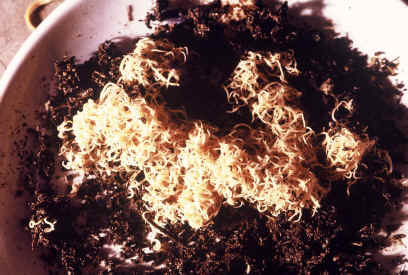
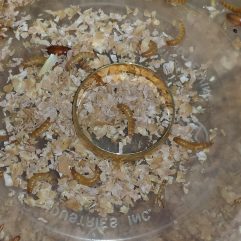
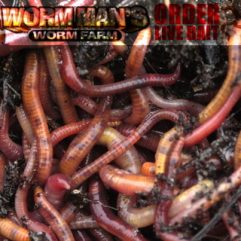

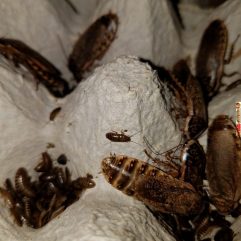

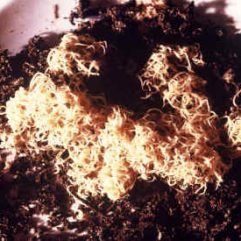
Reviews
There are no reviews yet.